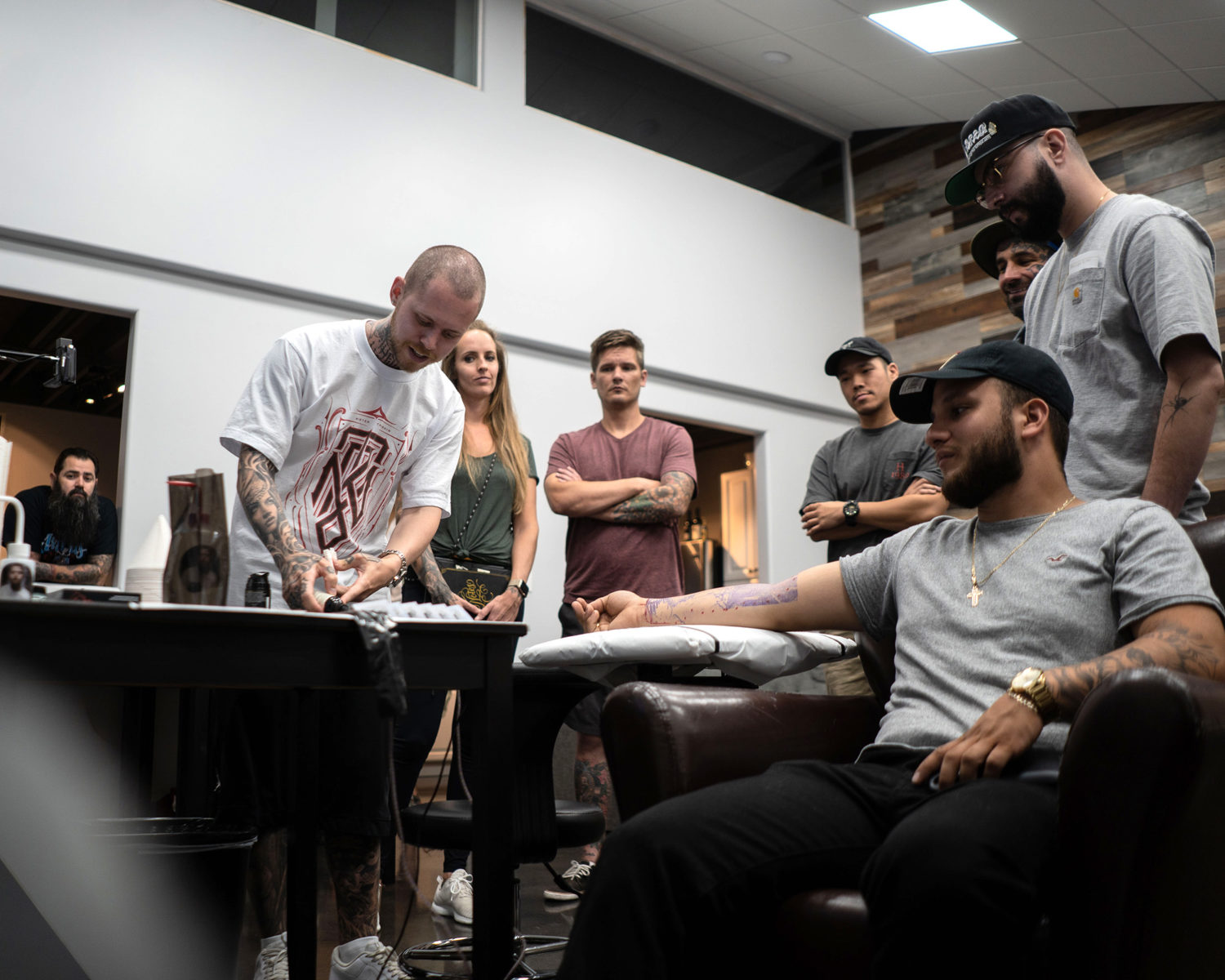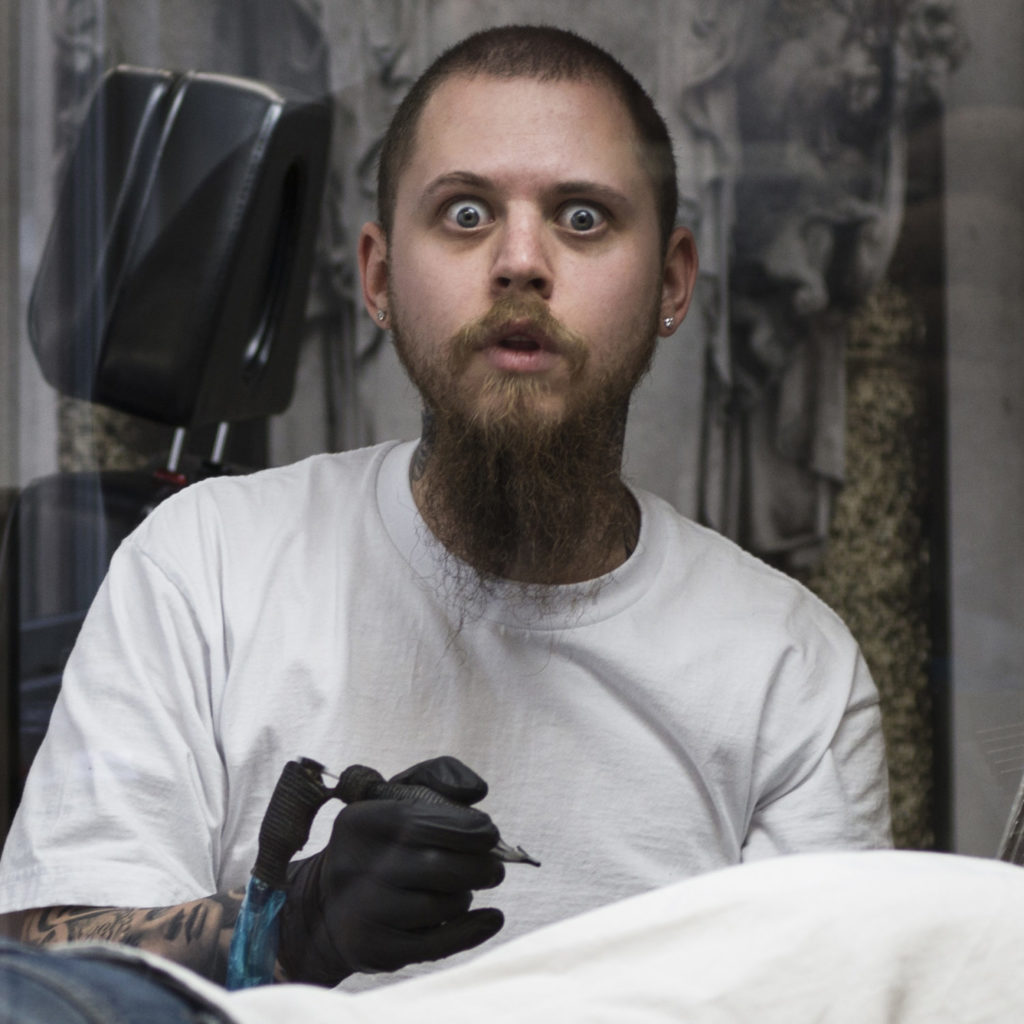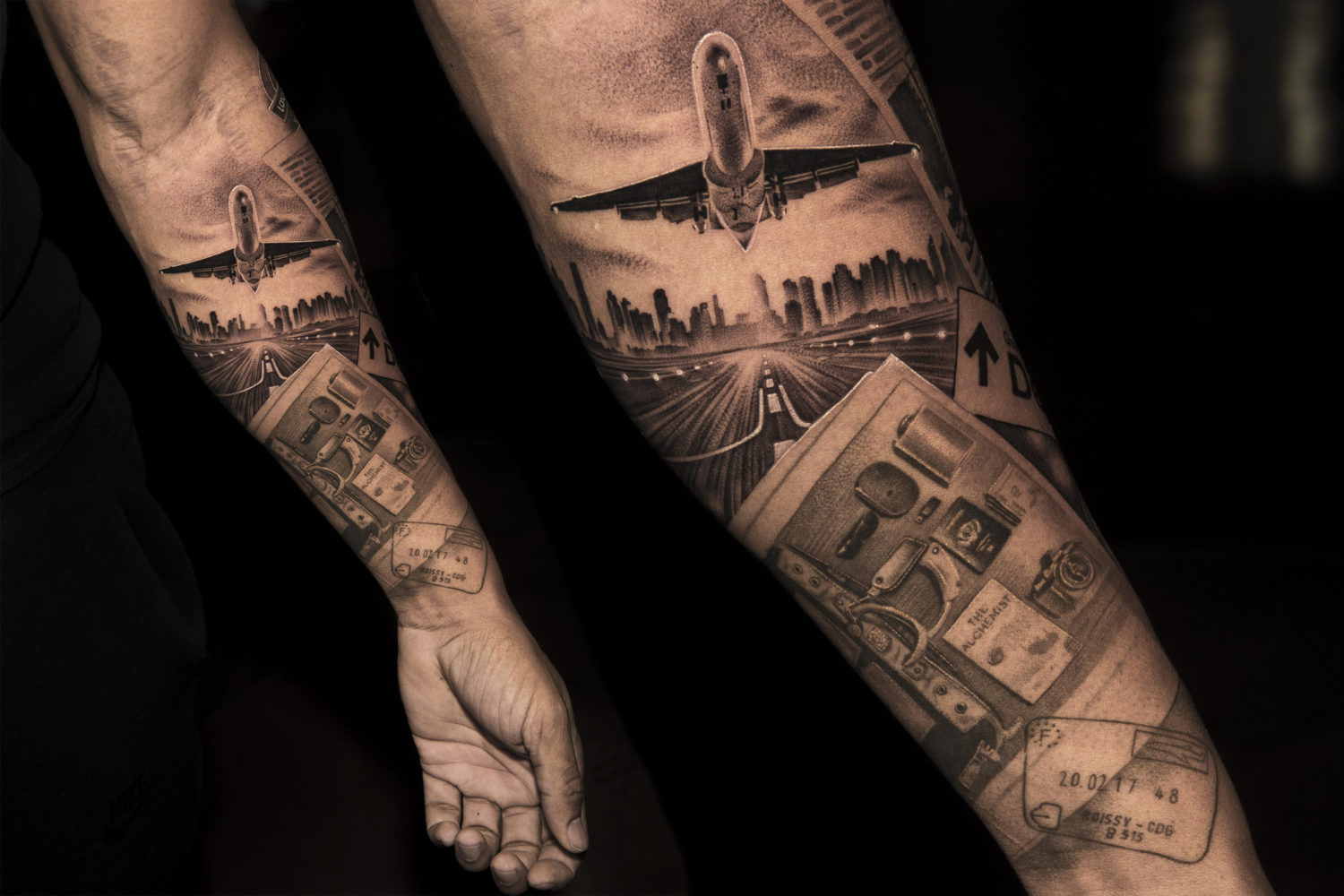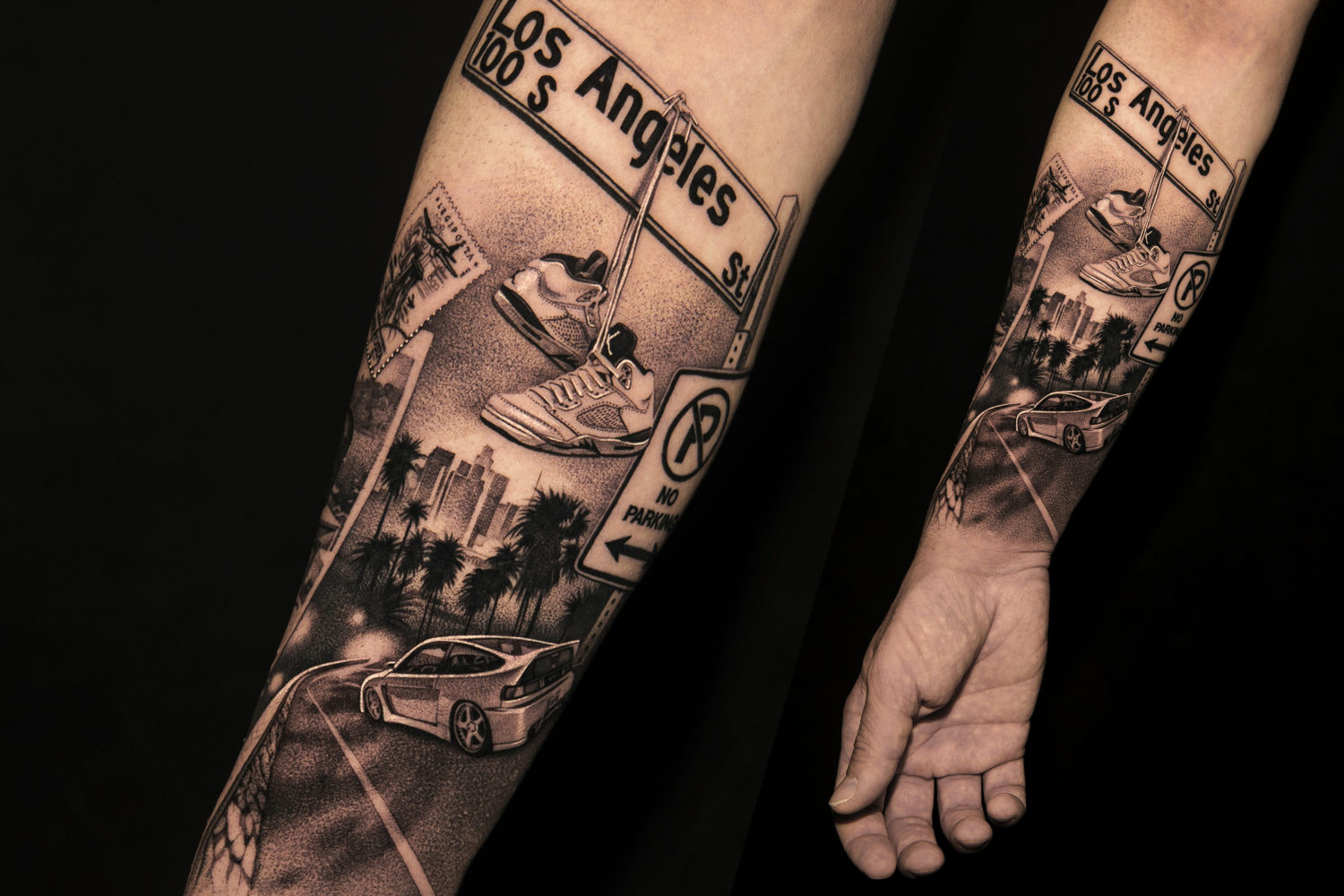Even as a teen living in Moscow, it seemed Dmitry Troshin — or as his 154,000 Instagram followers know him, @MisterTroshin — was destined to be recognized for his incredible artistic vision.
Now, living in Irvine — more than 6,000 miles away from Russia — Troshin works as a tattoo artist at the Lake Forest-based Vatican Studios tattoo shop. As an artist, Troshin has labeled himself a tattoo storyteller, constantly tapping into the mind’s eye of his client to garner clearer, more realistic concepts for the pieces he etches permanently into skin.
However, he is currently working to tell stories in different ways, now that he is currently among other tattooers on hold in California’s well-respected tattoo industry, all of whom are waiting to see how COVID-19 will change the culture of the art form they have designed by hand.
For the past few months, Troshin has spent his time watching Star Wars with his wife and dog, sketching, and riding his bike. Irvine Weekly had a chance to interview Troshin about growing up in Russia, his tattoo inspiration and how he ended up all the way in Irvine.
IRVINE WEEKLY: You’re originally from Russia. Can you give us a little bit of background on yourself and what living in Russia was like as a child? Did you ever think you’d be where you are now?
DMITRY TROSHIN: Yes. I was born and raised in Moscow, Russia. I have always been an antisocial, introverted kid, who loved being alone and drawing. Living in Russia was never too bad for me, but at the same time there was nothing really that motivated me to do something big. I never had an idea of what I wanted to become when I grew up, and I never thought that getting paid for doing art would be an option for me. Although moving so far away from home was always a dream for me — it did not look realistic either, given my circumstances then. It is still hard to believe where I am now and what I’m able to do for a living.
It looks like art is a really big influence on your everyday life. Has it always been that way? Does your family have a history of artists?
As far as I know, there are no artists in my family, but since I was born I’ve always been interested in different types of art. When I was 13, I started learning photography and at age of 14 I was even lucky enough to have some of my photographs exhibited in the Museum of Modern Art in Moscow. By 21, I managed to work in several different types of art related jobs — from a helper at a movie set and videographer at TV school to managing a photo lab, organizing exhibitions and doing graphic design for a few companies. Most of my jobs were either art-related or in sales, which also helped a lot. When I graduated as an interior designer, I still was not sure what to do next.
 Can you recall your first memory of a tattoo? What attracted you to the art form?
Can you recall your first memory of a tattoo? What attracted you to the art form?
I never liked tattoos (or thought of them as art) until 2011 when I came across some photos of beautiful black-and-gray style tattoos made by artists here in California. Religious and Chicano inspirations impressed me so much that I started thinking of tattooing as a new hobby or even a job, eventually. It seemed like a natural evolution of what I was already doing. I began to draw even more and start preparing sketches of references like what I saw online. It also pushed me to study classic art for stylistic influence, and to learn more about sculpture and fine art.
How long have you been tattooing?
I started tattooing in 2012, after a year of research and absorbing all the information I could find online. I even started a little business just to get closer to the tattoo industry — I was selling Sullen Clothing brand (also a California-based company) T-shirts — I had a setup in a corner in a tattoo shop so I could hang out there and ask questions about tattooing without looking too weird. When the time to start tattooing has come, I traded all the products I had in my store for a set of tattoo equipment and started practicing on my friends and their friends.
Can you break down the idea of what you consider a “tattoo storyteller”?
After a few years of doing all kinds of black-and-gray tattoos, I got bored of the similar ideas I was seeing, using the same references as others. I found that what makes my brain work and pushes me to be more creative is more challenging — the concept of making compositions of different objects important to my clients and having them flowing together into a story that you can read just by looking at the finished project. I began asking my clients about their memories, travels, dreams and other objects they really enjoyed in life to create unique compositions for them individually, instead of reproducing tattoos they saw on somebody else. That is what tattoo storytelling means to me.
What do you consider your current tattoo style? If you can, maybe explain how your style has progressed or changed over the years?
I would say that it is still realistic black-and-gray, but as I’ve progressed in my career I’ve become more well known for using one type of needle for everything — the 3RL, which stands for 3 Round Liner. In the last several decades, most tattoo artists used and combined many different kinds of needles in their tattoos — I wanted to simplify my tattooing process and make it closer to pencil drawing as I have done all my life. The 3RL needle is a small needle — think of it like a #2 pencil, in a collection of writing instruments ranging from this to a big marker. I found that using only that needle size is as close as possible to using a pencil as a tattoo needle can be and allows for a pepper-shading texture on the skin that I really prefer. I started to cultivate that style in my own work and since 2015 I’ve even been doing seminars and workshops to teach other artists these techniques.

(Courtesy of Dmitry Troshin)
Is there a tattoo culture in Russia, and how does it differ from the American, West Coast culture of tattooing?
There are many great tattoo artists in Russia, as well as artists of other mediums. The current economic and political situation, however, has caused many of them to move to other countries. Most of the tattooers I know have either moved already or are thinking about moving. Based on my experience, there’s more trust from client to artist to create something new and innovative here in the U.S. than in Russia. That is slowly changing in Russia — I look forward to when people become more open-minded there too.
What brings you to Irvine?
My wife and I fell in love with this area once we saw it in person — it’s so quiet, nice and clean. Our lifestyle here is completely the opposite from what we had before — living in a huge, busy city like Moscow — and we’re enjoying the change. It is amazing to have the opportunity to be close to a large metropolitan area like L.A. and at the same time be surrounded by parks, beaches and mountains. I also happen to work in the legendary Vatican Studios, which is located just a few minutes away in Lake Forest.
How does one get sponsored by Bishop Rotary? Can you give me a little background on how you came to have a working relationship with such a legendary company?
Bishop Rotary has always been synonymous to West Coast black-and-gray tattoo culture for me. Nearly all the artists I looked up to before I began tattooing were a part of the Bishop Family, and once I got a chance to know the people behind this company I knew where I wanted to be. Eventually, I had an opportunity to join the family myself and move here. I had no hesitation in doing so. For other artists looking for sponsorships, my main question is this: “Why do you want that? What is your goal?”
Tattoo equipment is far more accessible these days — any tattooer can afford buying new equipment with enough time and effort, so being sponsored is more of a deeper relationship. If you love the brand you are wanting to be sponsored by, and willing to support it in any way — that’s a good enough reason for me. Do your job better than others, be unique in your art, and show your passion for the brand, to the brand, and most likely you’ll get where you want to be.

Dmitry Troshin
Can you give our readers an overview of what exactly the book All of Me Is Illustrated is and what it was like working on such an incredibly artistic project?
All of Me Is Illustrated is a book created in collaboration between Lawrence Schiller (a famous photographer, filmmaker and author) and the legendary Inked magazine. It combines Ray Bradbury’s stories with photographs of some amazing tattoo artists and their art. I was fortunate to be invited to join this project and it’s been a huge honor to be published alongside such legendary artists. This book has been an important part of tattoo culture history — showing people that tattooing is a real form of art. It was also the first time I had to sign over 300 copies of limited-edition books.
So, this lockdown has been pretty surreal for most people. How are you coping with lockdown life in Southern California?
Despite all the bad things happening because of the virus, it’s been a great obligated chance for me to finally take some time away from tattooing, as I’ve been doing it without a break for years. I finally got some time to work on other projects and ideas I’ve had in mind — one of them is my new YouTube show “Boring Tattooer,” where I share everything I’ve learned about tattooing and tattoo culture. My hope is that it will help a lot of artists to learn something new and make the whole industry more safe and transparent.
It looks like COVID-19 will change life for a lot of people. As tattooers get ready to return to work in Stage 3 of the California’s Reopening Plan, how will the tattoo industry be affected?
There will be some interesting effects from COVID-19 on the tattoo industry. I think that when we do open, we may experience a sort of recession. Many people are having financial problems now and getting a new tattoo is definitely not a necessity. At the same time, I have noticed that some of my fellow tattooers had a chance to start doing other things as well — they seem happy to spend less time tattooing and have more time for their new projects that may have been put aside for a while. I hope that this pandemic will make people more cautious and aware when it comes to personal hygiene, which would help the industry to become safer as well.
Advertising disclosure: We may receive compensation for some of the links in our stories. Thank you for supporting Irvine Weekly and our advertisers.






